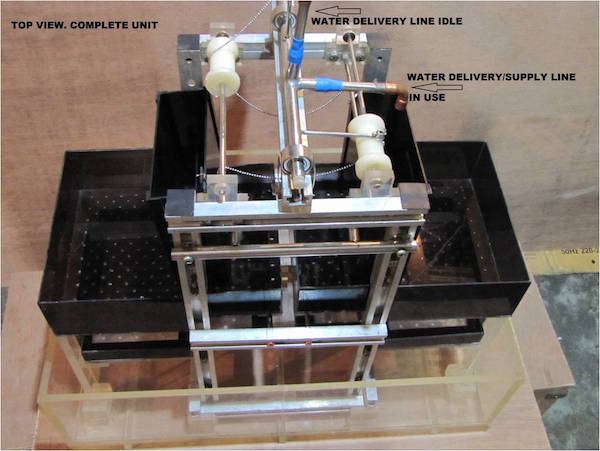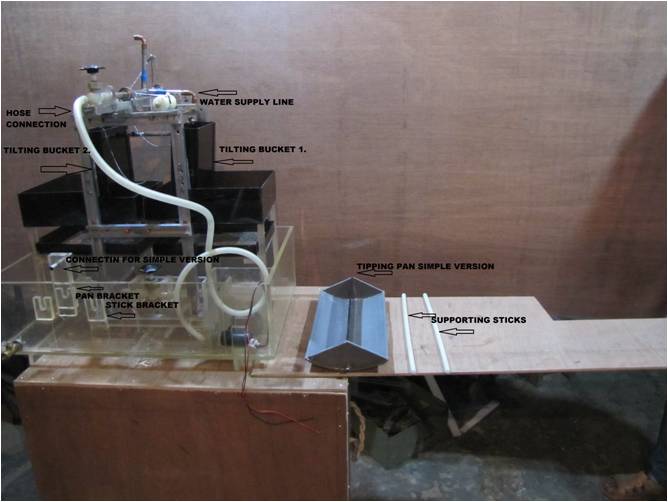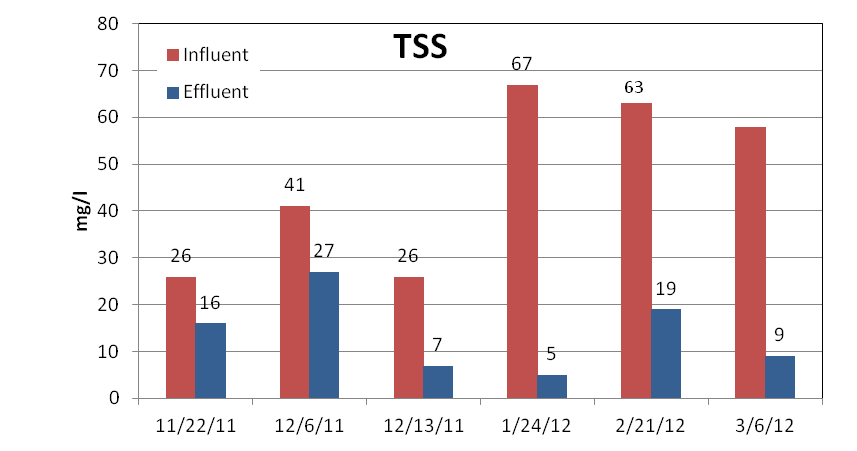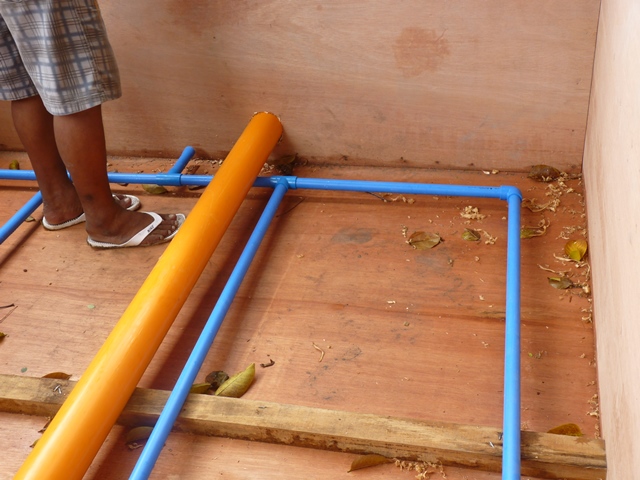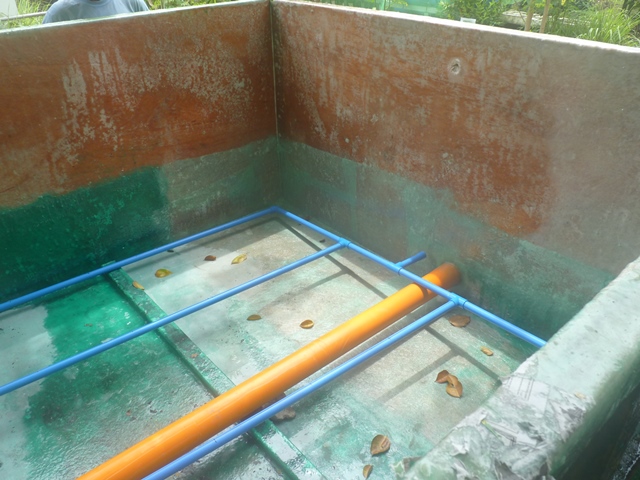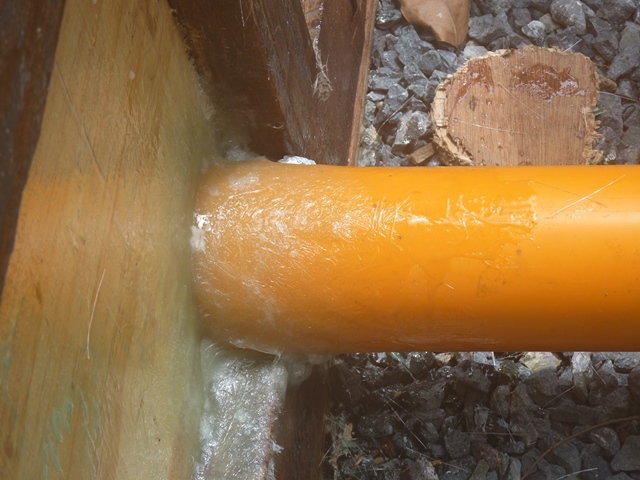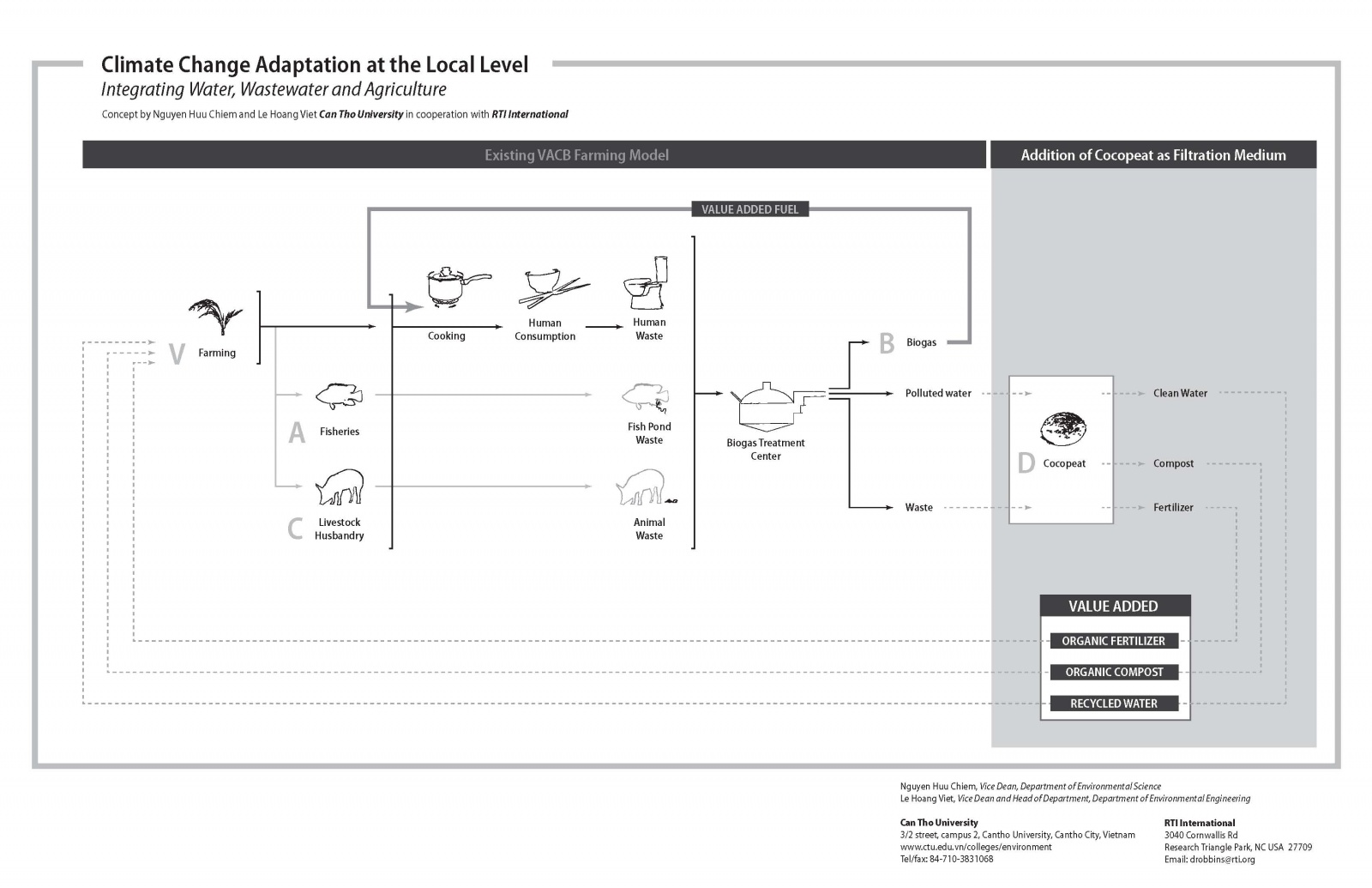Practitioner's Tool / Case Studies: Cocopeat Implementations in South-East Asia
Below you find a series of case studies on the topic of cocopeat filters. The text derives from blog posts from the former website watsanexp.ning.com.
Contents
[hide]- 1 Institut Teknologi Bandung (ITB) Launches Cocopeat Demonstration Project at their Bandung, Indonesia Campus
- 2 Cocopeat System Dosing Technology - Innovations by Edeltech Engineering, Bangladesh
- 3 Interim Results - Cocopeat Testing at Putatan Elementary School Muntinlupa City, Philippines
- 4 How We Built Our Cocopeat Bio Filter - by Jet Pabilonia
- 5 Community Resiliency Through Wastewater Treatment in Vietnam - A Can Tho University Research Study
Institut Teknologi Bandung (ITB) Launches Cocopeat Demonstration Project at their Bandung, Indonesia Campus
The Institut Teknologi Bandung (ITB) in conjunction with RTI International launched their pilot scale cocopeat demonstration project this month (April) with the purpose of demonstrating low cost and sustainable wastewater treatment technology in Indonesia. According to team leader Dr. Rofiq Iqbal, "cocopeat materials are readily available in our country. In fact, they are highly available, and for our case, the manufacturer gave them to us for free. There are many coco fiber industries located near the shoreline, and in Java Island they are scattered throughout the region. If we can show that the technology is truly low cost and works well, it could be widely applied here in Indonesia to help us control our wastewater discharges".
"The cocopeat filter we are designing for this study is basically a box 1 meter wide by 1 meter deep and .7 meters high. It is made of plexiglass so we will be able to see the water levels in the filter, which will help us judge how long it takes for a particular dose of effluent to pass through the medium. We may do some dye testing later to demonstrate this. We have also decided to use pressure dosing technology similar to what our counterparts in the Philippines are using. The pressure dosing will help to provide even distribution to the filter and allow us to more accurately control the dose volume and timing, as well as the loading, or how much volume of wastewater can be applied to a given surface area of filter."
For this test, effluent is pumped directly from the septic tank that serves offices and student activity rooms. The system works by spraying the septic tank effluent over the filter through a series of pipes, with specially drilled orifices. The effluent drops onto a thin (10 cm) mat of coco fibers which are placed on top of the cocopeat. This helps to distribute the effluent evenly over the filter. The fibers have many void spaces where oxygen transfer from the atmosphere to the effluent can occur making this an aerobic process. "In practice, we believe that cocopeat systems for use in Indonesia will be either pressurized, like our test facility on campus, or as gravity flow systems that utilize simple non-electric dosing mechanisms for sites where very low cost installations are required", according to Pak Iqbal.
ITB's cocopeat testing program is scheduled to run through September, 2012, after which significant data will be provided to evaluate the concept that cocopeat may be used to treat wastewater. Once proven, ITB will take the lead in implementing demonstration projects in and around Bandung to show how low cost wastewater technology can have a real and positive impact in their community.
Editor's Note: RTI's cocopeat study is being funded by the Bill and Melinda Gates Foundation's Grand Challenges Explorations initiative. Thanks to Rofiq Iqbal, Ph. D from the Environmental Engineering department at ITB for his work on this project. His vision and enthusiasm for advancing the study and implementation of low cost wastewater treatment is greatly appreciated by the entire cocopeat evaluation team.
Cocopeat System Dosing Technology - Innovations by Edeltech Engineering, Bangladesh
Dosing, as it relates to the cocopeat technology demonstration projects, refers to the mechanisms by which settled sewage flows to the cocopeat biofiltration unit where it receives additional treatment. In the Philippines demonstration projects, wastewater is dosed under pressure to the cocopeat filters using effluent pumps and timers. This method of dosing was chosen for these experiments as it provided regular and measurable flow volumes that make it easier to quantify the pollution removal efficiencies given the daily volume of wastewater applied to the filter.
In the real world however, the cocopeat systems must be as flexible in their design as possible to be useful in a variety of site conditions. Showing how this technology can be utilized in "off-grid" applications where gravity is the only source of energy to accomplish dosing is a critical need.
The photo to the left is of an early version of the dosing unit created by Edeltech Engineering. In this model, wastewater effluent flows to the unit under pressure, although gravity flow will also work. The flow is directed to the tipping bucket on the right. When it reaches a set level, the tipping bucket tips to accomplish the dose, while shifting the fill nozzle over to the tipping bucket on the left. The cycling repeats as the flow of wastewater continuously fills and tips the buckets to achieve intermittent dosing without the requirement of electricity.
The dosing unit is important for gravity flow cocopeat units as it provides for intermittent dosing. Small periodic doses allow for cycles of wetting and drying on the filter surface, which it is believed helps to entrain atmospheric oxygen into the filter media. This has been shown to be the case in our Philippines experiments as the influent wastewater is devoid of dissolved oxygen (DO), but DO is present in the effluent. Small amounts of oxygen in the filter help to maintain a varied and vibrant crop of beneficial bacteria responsible for removal of organic matter and pathogens found in the wastewater.
Edeltech Engineering is also working on a simplified version of the unit that is lower profile and could be used for the simplest cocopeat applications. In this version, the tipping pan, showed at the far right right provides positive dosing from gravity flow. The cocopeat filter would be divided into two separate compartments with the tipping pan located over the division. The pan would tip to one side when full, and then the other side as the pan re-fills. This unit would also provide for intermittent dosing and enable the technology to help achieve very low cost installation.
This concept is represented in the drawing to the right.
Editor's note: Special thanks to Md. Nazmul Hasan and his team at Edeltech Engineering for their work on these innovations. Edletech Engineering is located in Dhaka Bangladesh and is expert in fabricating electro-mechanical technologies in support of Bangladesh's growing environmental field. Photo: Mr. Abdur Rauf, a technician of Edeltech Engineering adjusts the dosing mechanism for intermittent dosing through gravity flow.
Interim Results - Cocopeat Testing at Putatan Elementary School Muntinlupa City, Philippines
The Putatan Elementary School cocopeat wastewater system treats toilet wastewater generated from approximately 450 students and faculty. The toilets are portable-toilet style facilities donated by the United States Agency for International Development (USAID) just after the Typhoon Ondoy crisis of 2009. These are pour-flush toilets where students are responsible for flushing after each use. Students are instructed to use approximately 4 liters of flush water after each use. Flow from the toilet blocks is averaging 1.8 cubic meters per day, which provides for a surface loading rate of 550 liters per square meter of cocopeat filter surface area each day. For the analytical services, RTI is subcontracting with NCA Labs, a division of Test America. This is a Department of Health (DOH) and Department of Environment and Natural Resources (DENR) licensed laboratory that utilizes Quality Assurance / Quality Control (QA/QC) procedures consistent with their partner laboratories in the United States. Parameters being tested from the influent and effluent of the cocopeat filter include:
- Biochemical Oxygen Demand (BOD)
- Total Suspended Solids (TSS)
- Temperature
- pH
- Conductivity
- Fecal Coliform Bacteria (expressed as most probable number - MPN)
The test results are presented below for BOD, TSS and Fecal Coliform Bacteria in Charts 1, 2 and 3 respectively.
A few points to note:
- The influent to the filter is quite weak. One would expect BOD and TSS from septic tank effluent to range from 75 mg/l to 150 mg/l. In this case, the septic tank is working better than expected, meaning that the filter is lightly loaded. This could be a result of excessive dilution.
- Despite the relatively low strength of the influent wastewater, it is clear that the filter is accomplishing a fair degree of treatment. BOD and TSS reduction are averaging 90% removal efficiency, while Fecal Coliform removal efficiency is averaging 95% with a high of 99%.
- At this early stage of the testing, it appeared that the BOD stabilized after the first testing cycle (2 weeks), while the TSS stabilized after 4 weeks. We will continue to watch these trends over time to determine if true stabilization occurred. This will provide important information related to start-up periods and compliance during start up.
The project team would like to thank the professional staff of NCA Labs in Makati City, Philippines for their contribution to this program. We would especially like to recognize Charlene Tang, Belle B, Sherydelle Laguitan, Mylene Ramos, Emil Siervo, and Lucile Lahaylahay for their competent and professional work. For more information on NCA Labs, contact Lucile Lahaylahay at lucile.lahaylahay@ncalabs.com.ph or visit them on line at www.ncalabs.com.ph.
Editor's note: This blog post presents the preliminary testing results from our cocopeat study at the Putatan Elementary school in Muntinlupa City, Philippines. This project along with RTI's other cocopeat testing activities received funding through the Grand Challenges Explorations, an initiative created by the Bill & Melinda Gates Foundation. As with all of our test results, these are still preliminary, representing just 3.5 months of testing.
How We Built Our Cocopeat Bio Filter - by Jet Pabilonia
Our first cocopeat demonstration project is located at a school in Muntinlupa City, which is just south of Manila. For our test system, we elected to pump the effluent from the school's septic tank to the cocopeat filter. The pumping allowed us to control the flow, which was needed for our testing. Here are the steps we followed to build this system.
- Preparing the site. Locate the site where the filter box will be constructed. The site should be in an area that is elevated slightly so that surface water from storm events will not flood the system. Once the site is selected, level it and place 5 cm or so of gravel or sand to prepare a firm foundation for the filter box.
- Size the filter box. We used the cocopeat Septic Tank Sizing Worksheet tool to determine the filter size. From this tool, we determined the filter box size should be 2.4 meters square and 1.2 meters deep.
- Build the filter box. Filter boxes can be constructed out of lumber, hollow block, or other structural materials. We chose lumber as it was readily available. We used typical framing lumber and plywood to construct the filter box. We used nails and screws to secure the plywood to the frame so that it would last.
- Drilling the transfer hole. We drilled a hole just above the floor of the filter that would allow the collection pipe to pass through the filter. The purpose is so that the treated effluent can be collected and sent to the irrigation field. For this installation, we determined that the collection pipe would sit about 6 cm above the floor so that is the elevation we used to locate the hole.
- Plumbing. There are two sets of pipes for our cocopeat filter. The orange pipe shown here is 10 cm PVC pipe that is the under-drain. It has 1 cm holes drilled at the bottom of the pipe, which are spaced every 10 cm apart. This pipe sits at the bottom of the filter, a few cm above the floor and collects the treated effluent. In this picture, you can see the orange collection pipe passing through the hole. The blue pipe is 2 cm PVC. It is shown sitting on the floor of the filter, but it was only placed there for the assembly. The blue pipe is the effluent distribution pipe, which sits on top of the cocopeat once it is installed. This pipe is used to evenly distribute the effluent throughout the cocopeat media. The blue pipe will be connected to the pump system. It has .25 cm holes drilled along the top placed every 50 cm. The holes will be covered by shields so that when the effluent sprays out of the holes during pump cycles, it splashes off of the shield and drips down onto the cocopeat, helping to get better distribution (and aeration).
- Waterproofing the filter box. The filter box must be waterproof. The type of box construction will dictate what type of water proofing you can use. For our lumber box, we chose to use fiberglass, although we could have used a PVC or plastic flexible liner. For the fiberglass, we used resin and fiberglass sheets to totally seal the box. And we did this inside and outside to protect the lumber so it would have a long life. Again, note that the blue distribution pipe is just sitting at the bottom of the box. This will eventually be placed on top of the cocopeat media.
- Sealing the transfer hole. We took extra care to ensure that the transfer hole where the collection pipe passed through the filter box was completely sealed. We used several layers of fiberglass matting, each with its own coat of resin to accomplish this.
- Protecting the collection pipe. Once the collection pipe was in place, we covered it with gravel. The gravel serves two purposes. First, it provides a bed for laying the collection pipe at the correct elevation. Second, it helps protect the collection pipe from getting clogged with fines that may wash down through the filter material during the first few weeks of operation. For the the gravel, we first made a bed that was 6 cm deep. This was the proper elevation we had previously determined for the collection pipe. Once the gravel bed was in place, we laid the collection pipe on top of it (with the holes down) and covered the entire pipe with more gravel, so that the collection pipe was completely covered by about 5 cm of gravel. NOTE: It is important to use washed gravel so there are no fines. Fines, or sand particles can clog the holes in the collection pipe. Also, make sure when you order the gravel that it is larger diameter stones than the size of the holes in the collection pipe. In our case, the holes were 1 cm, and the gravel we used was 1.5 cm.
- Placing the cocopeat. Our plan called for a media depth of .7 meters. The box is 1.2 meters tall, and we have a total of 21 cm of gravel at the bottom of the box (6 cm gravel bedding, the pipe is 10 cm, and 5 cm of gravel over the pipe). Therefore, we knew we needed to fill the box with cocopeat so that the top of the media was at an elevation 29 cm below the top of the box. Once the cocopeat was placed to the proper height and leveled, we added 15 cm of coco coir fibers on top. The idea is that the fibers will help to evenly distribute the effluent to the surface of the media. It might also help with oxygen transfer.
Notice in this picture, the blue effluent distribution pipe is now connected and sits on top of the fibers. Also, the fiberglass coating is completely installed, and the filter box painted on the outside for additional protection against sunlight (fiberglass degrades in direct sun).
So that is how we constructed our filter box. In a future post, I will describe how we installed the pump, controller and flow meter. The pictures provided here are from our first installation, at the Putatan Elementary School. We recently completed our second installation at the Muntinlupa Science High School, and it went much smoother. It took us only two weeks to install that one.
I hope our experience helps to inspire you to build your own pilot cocopeat project and help demonstrate the benefits of this low cost technology. If you have questions, please send them through this web page and we will be sure to answer them. Good luck!
Editor's note: Jet Pabilonia is the Head of the Muntinlupa City Environmental Protection & Natural Resources Office, and also manages the Laguna Lake Management Office for the city government. We are happy to have him on our cocopeat testing team.
Community Resiliency Through Wastewater Treatment in Vietnam - A Can Tho University Research Study
This component of the program tests cocopeat as a low cost biofiltration medium for community wastewater treatment and agricultural reuse. The Can Tho study, led by principal investigators Nguyen Huu Chiem and Le Hoang Viet tests the cocopeat technology for use in their V-A-C-B -- D wastewater model described below. Can Tho University, located in the heart of the Mekong Delta, is a regional center for testing low cost and sustainable wastewater treatment solutions. Thanks to both Chiem and Viet for their contributions to this program.
Can Tho University's contribution to RTI's cocopeat testing program is to utilize the recirculating and continuous flow model for testing the viability of cocopeat as a wastewater treatment medium. Up until now, testing has utilized the intermittent flow model, or single pass system, where wastewater is applied to the surface of the filter, and then flows through the medium into the discharge structure. In the Can Tho study, wastewater is applied to the filter and then recirculated through the medium to model a high-rate reactor.
The bench scale test facility, pictured on the left, has been constructed to provide a surface area of 1 square meter. The wastewater flow rate is 160L/day and the recirculation flow rate is 300 L/day. Therefore, the hydraulic loading rate is 160 L/m2/day (without consideration to recirculation) or 460L/m2/day (including recirculation).
This research will provide inputs for determining the optimal design of the reactor. Specifically, the optimal loading rate (liters per day per square meter) as well as the depth of the media. Both Chiem and Viet have high hopes that the cocopeat system will demonstrate a low cost and simple method of effluent treatment, so that the effluent can be safely used for irrigating crops. Once proven, cocopeat technology will become an integral component of the V-A-C-B -- D model for wide-scale community wastewater treatment and resiliency.
Under the V-A-C-B -- D model, waste from livestock, fisheries and homes flows to a central biodigester, where methane gas is captured for domestic uses. The effluent from the cocopeat reactor can then be used for agricultural irrigation. The model can be seen on the left.
An additional benefit realized by utilizing the cocopeat reactor is that spent cocopeat can be mixed with reactor sludge to create a high quality compost that can be used as a soil amendment.
The V-A-C-B -- D model, as envisioned by Viet and Chiem can help build community resiliency to climate change and other factors. Enhancing community agricultural systems through the addition of high quality compost and nutrient-rich irrigation effluent helps increase yield and local food security. Methane, generated from the biodigester can be used for cooking, replacing traditional fuels, such as wood or coal. Methane is a cleaner burning fuel that can also reduce indoor and community air pollution.
"Improving community wastewater treatment and sustainability is a primary goal of this activity" according to Dr. Chiem, chief researcher for the study. "If communities can be strengthened by enhancing agricultural systems through nutrient and effluent recycling, they are more able to adapt to climate change, which is a real threat here in the Mekong Delta. Such a program could have real and measurable impacts to local economies, environmental health and disease reduction".
The Can Tho University Cocopeat study is expected to produce preliminary results later this summer. Check back for updates, which will be posted here as they become available.
Editor's note: In January 2012, Can Tho University started up its component of RTI's cocopeat wastewater treatment program. This project along with RTI's other cocopeat testing initiatives received funding through the Grand Challenges Explorations, an initiative created by the Bill & Melinda Gates Foundation.

